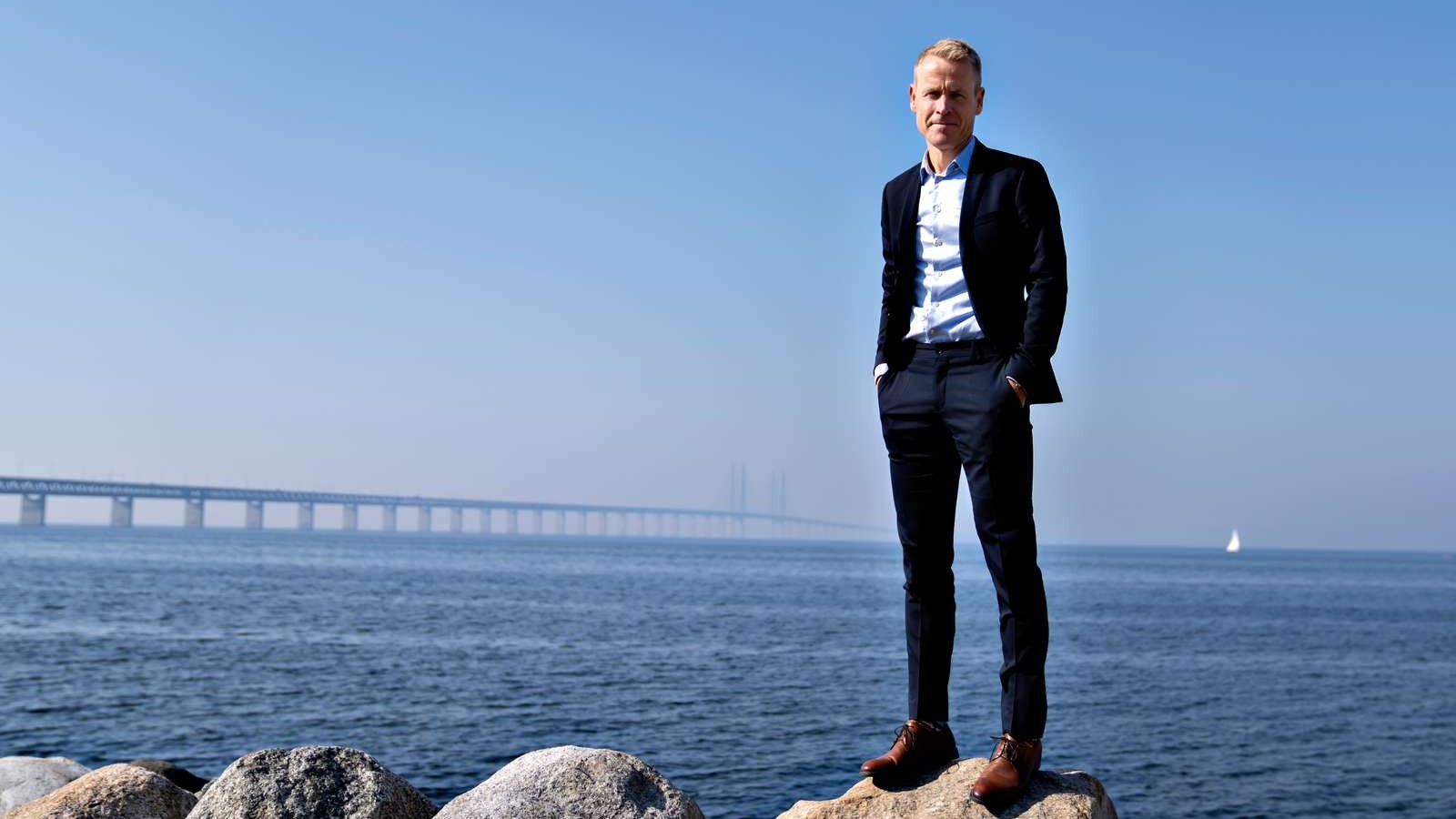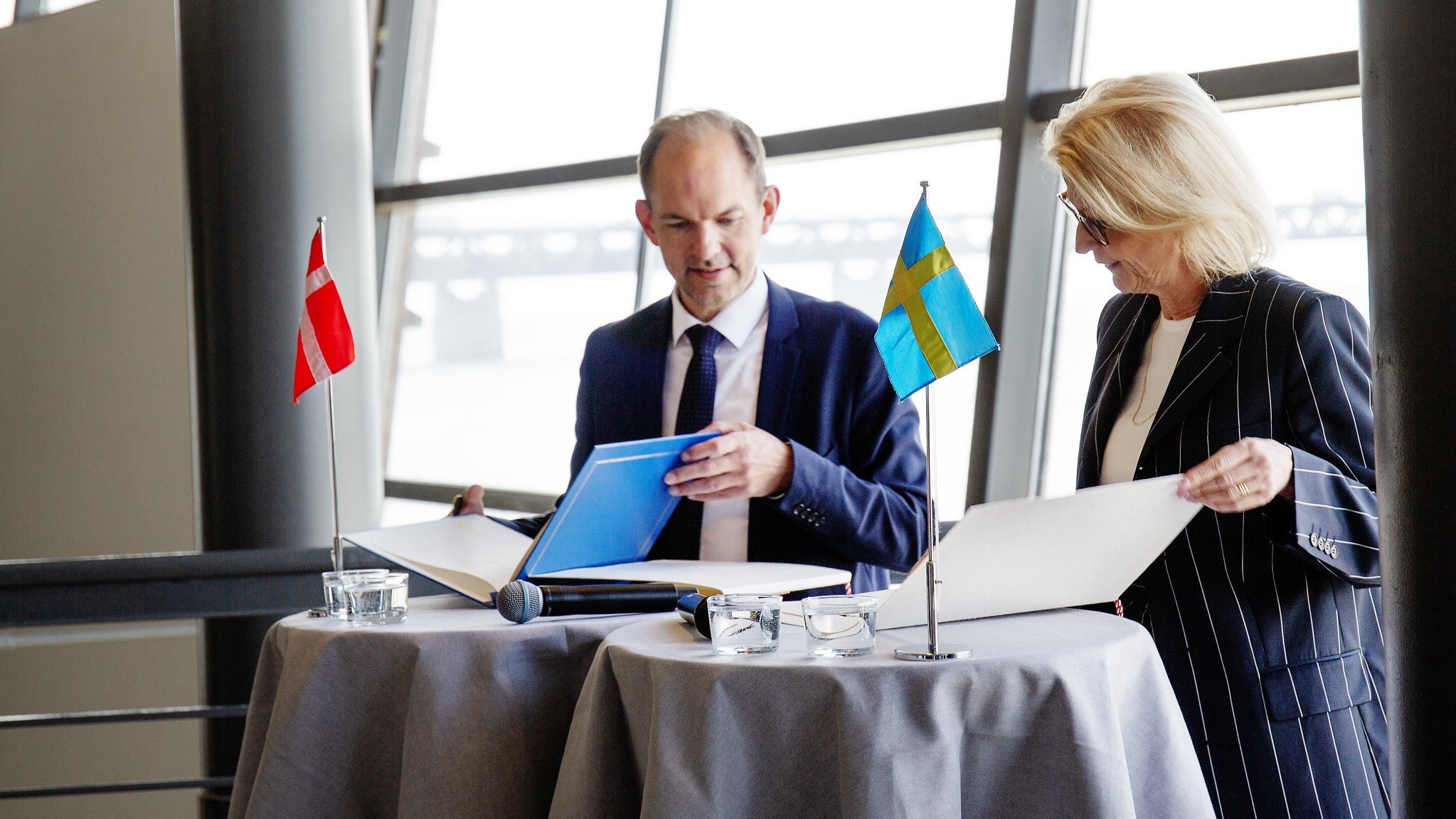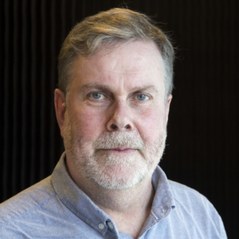The Øresund Bridge: 25 years in a region that creates dynamics
The Nordic region’s largest labour market this year celebrates 25 years of a fixed link between two countries, in a border region without its own legislation. Instead, two countries must coordinate and cooperate based on their respective laws and regulations.
“It’s important to highlight the closeness and friendship between our countries. Countries at war are not destined to preserve their enmity. There is also a way out. The sibling-like bond between Denmark and Sweden is an example of this,” says Hans Wallmarks, Sweden’s ambassador to Denmark.
He is referring to the oft-repeated claim that Denmark and Sweden are the two nations that have fought each other the most times. It is worth mentioning that Sweden holds what is often called “an unbeatable world record in peace”. The country has not been at war in more than 200 years.
We shall return to the ambassador to hear what he and three other people the Nordic Labour Journal has met think about what the 25-year-old Øresund Bridge has meant for a region with a high concentration of people, businesses and universities. And what it has meant for the Nordic region.
Aiming for an integrated labour market
The decision to build a bridge between the two countries was made by the Swedish and Danish governments in March 1991. The driving force behind it was to create an integrated labour market.
Today, the Øresund region is the largest labour market in the Nordic region, with a population of 4.2 million people.
Smooth transport links a strength
Linus Eriksson, CEO of the Øresund Bridge since 2020, is impressed with how traffic between Sweden and Denmark has been organised.
“We have an incredibly well-organised system in this region where the bridge acts like the main artery. You can get on the train at any station in Skåne and even travel from Gothenburg, Kalmar and Karlskrona all the way to Copenhagen Airport,” he says.

"It is reasonable to expect that transport services work," says Linus Eriksson, CEO for the Øresund Bridge. Photo: The Øresund Bridge
With his background as director of traffic at Skånetrafiken and regional head of traffic management for all road and rail traffic at the Swedish National Rail Administration, now the Swedish Transport Administration, he has long been committed to meeting the customers’ needs.
“We have around 1,800 commuters living on the Swedish side who work in the health care sector in Denmark. They have to get to work on time. For them and all the other commuters, plus those who are crossing the Sound for other reasons, it is reasonable to expect that transport services function properly.”
Another one?
When an additional fixed link between the two Nordic countries is discussed, one question that often pops up is whether there is a lack of space on the bridge itself. Linus Eriksson responds.
“We’re only using two-thirds of the rail capacity. The railway will not be full for another 50 years. There’s also room for more traffic on the motorway.”
But things might change already in four to five years when the new Fehmarn Belt fixed link between Germany and Denmark opens. An immersed tunnel will shorten the journey between Puttgarden in Germany to Rødbyhavn in Denmark to seven minutes by rail or 10 minutes by car.
A train journey between Malmö and Hamburg will take around three hours.
“The bottlenecks will move north since Denmark is already expanding its railway capacity at Copenhagen Airport, and Germany is about to do the same.
“Meanwhile, Sweden’s planned two new tracks between Lund and Hässleholm will not be ready until 2048, even though the decision was made in the autumn of 2023. This could lead to congestion at the Bridge’s land connections,” says Linus Eriksson.
The same government decision includes an expansion of these land connections – the motorways and railways leading to the Øresund Bridge. But construction has yet to begin, says Linus Eriksson and adds:
“These are not major projects, they could be carried out within one to two years if we wanted to. So in summary, Sweden is lagging behind.”
Before and after
In the 25 years since the Øresund Bridge opened, the areas near the bridge heads have developed significantly. Linus Eriksson sees this as a direct consequence of the decision to build the Bridge.
He mentions Ørestad on the island of Amager, east of Copenhagen, and its Swedish counterpart Hyllie, both districts with thousands of workplaces. Then there is the City Tunnel, Malmö Live, the Turning Torso and Malmö's college which is now a university.
“When Denmark and Sweden decided to build the Bridge, it created ripples. There really is a before and an after that decision.”
The Bridge unites
The Øresund Bridge CEO refuses to believe – despite the current global situation – that the best years have been the 25 that have passed since the Bridge opened. The potential for the Øresund region is enormous, he says, not least because of the large employers that are based here.
“Many more could commute across the Sound. Our aim for 2030 is to increase the number of commuters to 30,000,” he says, highlighting the Øresund Bridge as a strong symbol of the Nordic region.
“We are a bridge between two countries and we continue to build bridges. Like increasing tourism on both sides of the Sound through agreements with various stakeholders,” he says.
Linus Eriksson considers the cooperation between the Nordic countries to be good. He believes in it and wants more of it. The Nordic countries need to become even closer and meet physically more often, he argues.
“We have had various constellations of cooperation ministers visiting us several times,” he says, taking the opportunity to commend these ministers for their actions following the closure of the border between Denmark and Sweden during the Covid-19 pandemic.
“The Øresund region was not the best example of good cooperation between the countries at that time. Thanks to these ministers’ engagement, we will not see this happen again,” he says.
Border region or integrated region?
People were euphoric when the Bridge was inaugurated on 1 July 2000. This is confirmed by Uffe Palludan, a Danish national economist and futurist who has written several books about the region shared by Denmark and Sweden.
Uffe Palludan, Danish national economist and futurist. Photo: private
As early as 1990, he wrote an article about the economic opportunities of making Zealand and Skåne an integrated region. His starting point was the ongoing discussion about the EC’s internal market and a report from the EC Commission stating that the GDP of the European member states would increase by five per cent if all border barriers were removed.
“If the internal market could generate a five per cent increase, an integrated Øresund region should be able to do the same,” he says and adds:
“As long as you make it free to use all connections across Øresund.”
Palludan believes too much focus in the Øresund region has been placed on what he calls “the traffic aspect” rather than starting from the opportunities that already exist. So he recommends a visit to the pier at Skovshoved, an old fishing village ten kilometres north of Copenhagen city centre.
“From there, you see how the region is connected geographically. On a clear day, you can look south, east and north and see Copenhagen, Malmö, Lund, Landskrona and Helsingborg at the same time.
“Together, these cities have a large population and also a large potential to create a really integrated region,” he says.
To make something like this happen, you need knowledge about how the other country works – both at local and central authority levels. Businesses also need to exploit the synergy effects that can be had from cooperating across the Sound, believes Palludan.
In addition to schools providing more teaching in “the other language,” a frequently voiced wish from many involved in Øresund cooperation, Palludan proposes to coordinate employment policy between the countries, especially now that Zealand has a great need for labour while unemployment is high in Skåne.
He also proposes better traffic planning and the introduction of a bus metro across the Øresund – buses with frequent connections between Copenhagen Airport and central Malmö.
As well as a water shuttle between Helsingborg and Nordhavn in Copenhagen, where people can continue their journey by bus, metro, train and harbour ferry.
“The fact that the Øresund region’s potential hasn’t been fully utilised does not mean it doesn’t exist,” he says.

Denmark's then Minister of Finance Jeppe Bruus (Social Democrats) and Sweden's Minister of Finance Elisabeth Svantesson (Moderates) signed the new Øresund Agreement in early June last year. Photo: News Øresund
2024 – a special year for the Øresund region
Without entering a debate with Uffe Palludan, it is worth pointing out that last year saw several events that benefited the Øresund region’s development. Some of them included the following, in no particular order:
- A new tax agreement between Denmark and Sweden, long asked for by cross-border commuters, was signed by the countries’ finance ministers in June during the Greater Copenhagen Task Force meeting, a forum created to facilitate conversations between businesses and governments in Denmark and Sweden.
- The number of people commuting across Øresund using all types of transport rose to 21,585 in Q4. In comparison, the number was 2,788 in 1999, the year before the Bridge opened. Read more here (in Swedish)
- 2024 saw a record daily average of 105,212 personal journeys across Øresund. Read more here (in Swedish)
- Future surpluses from bridge tolls, once the state loans are repaid by 2050, will be used for infrastructure investments in the Øresund region. The Swedish bridge co-owner Svedabs’ loans for the land connections are expected to be repaid as early as 2029, which would free up a flow of funds. Read more here (in Swedish)
- The chair of the Confederation of Swedish Enterprise, Jacob Wallenberg, visited Malmö last September to discuss the Øresund region, deeper integration and opportunities arising from the opening of the Fehmarn Belt fixed link between Denmark and Germany.
- A fourth proposal for how road traffic between Denmark and Sweden can be expanded was presented by Sweco: Potential i befintlig Öresundsförbindelse. Så kan Öresundsbron framtidssäkras till år 2100 (in Swedish).
The Nordic Labour Journal presented the three previous proposals in two reports:
Looking outward
“We keep talking about border obstacles, but have not really moved on to the next step of the border region’s development with discussions of border dynamics and growth opportunities across the Øresund,” says Johan Wessman, CEO for Øresundsinstituttet knowledge base and think tank.
 “There has been a regional bubble with Øresund stakeholders talking to each other about border obstacles without including national players.
“There has been a regional bubble with Øresund stakeholders talking to each other about border obstacles without including national players.
“This changed a few years back with the establishment of the Greater Copenhagen Task Force. Even we at the Øresundinstitutte have for some years now been actively working at the national level and have established very good contacts with the countries’ ambassadors.”
In addition to conducting analyses and presenting facts as well as running the News Øresund news agency, the institute organises network meetings and specially designed trips for its Øresund network.
The aim is to help spread knowledge about the development in Denmark and Sweden, focusing on the Øresund region. They also invite stakeholders from outside the region.
“We realised that we had to work more towards Stockholm and organise meetings to show what the Øresund region is and how we work here. The institute will link people across the national borders and then happily watch something grow on its own,” says Johan Wessman.
Uneven distribution of the workforce
Johan Wessman notices optimism among people he meets in the Østersund region. But there is also unease about the future. Not just because of the global situation, but because Denmark and Sweden are becoming unbalanced when it comes to their workforces.
“We carried out an analysis of population trends and saw that the Danish workforce shrank by 300,000 people a year, while it increased by 400,000 in Skåne. But this could also positively contribute to more Øresund commuting,” says Johan Wessman.
There is already competition for labour between the two countries. Denmark gladly recruits Swedish healthcare workers and engineers, who are also sought-after in Sweden.
“The region might develop an imbalance if you fight for the same labour. One consequence of this is that Danish engineer salaries are starting to influence those in Skåne.
“This creates a stronger region and improved growth, which has effects that some like and others don’t,” says Johan Wessman.
An unresolved challenge is the difficulty for many job-seeking third-country nationals residing on the Swedish side to take a job in Denmark, even though the commuting time is short.
The Nordic Labour Journal described the situation in the article Aiming for full mobility in the Nordic region’s largest labour market.
Cross-border cooperation
So, we return to Hans Wallmark. He sees opportunities for further development of the Øresund region and other border regions.
He spent 16 of his 18 years as a Swedish MP in the Nordic Council. He also has practical experience of another border region, having grown up in Haparanda on the border between Finland and Sweden.
“There are similarities and there are differences between border regions. I’m optimistic enough to believe that the good examples will spread if you see the regions for what they are.”
Hans Wallmark and Denmark's ambassador to Sweden, Kristina Miskowiak Beckvard Photo: News Øresund
The ambassador believes the measure of successful integration is that the experience feels like moving within one region rather than between two countries.
“We’re not there yet, but the work continues and progresses. The starting point was the year 2000. Integration is better now. The ambition is to be even better in 25 years. The drive to improve is still there,” he says.
An important part of an ambassador’s role is to promote their own country in the host country. In that regard, Hans Wallmark has joined forces with Denmark’s ambassador to Sweden, Kristina Miskowiak Beckvard.
“We have two angles to the same task – to do as much good as possible for Denmark in Sweden and vice versa.”
Earlier this year, they held a joint presentation called “What can we expect from the good cooperation between our countries?” during the Real Estate Øresund event, where 300 Swedish and Danish community builders participated.
Hans Wallmark highlights the prosperity and stability of the Nordic region but also wants to raise a cautionary note about taking too much for granted.
Given the difficult and complicated global situation, as he puts it, we need to open our eyes to what we have right before us and protect what we have to avoid risking losing it.
The Nordic identity is important, as is the friendship between the countries, says Hans Wallmark.
“We have no better friends than this extended family that the Nordic countries represent. It’s proven that when times get tough, we draw our strength from those who are closest to us.”
- Royal attendance at anniversary celebration
-
The Øresund Bridge is celebrating its 25th anniversary, and just like at the inauguration, the occasion will be marked with royal splendour. On 1 July, the Swedish royal couple will welcome their Danish counterparts.
Photo: Øresundsbron
 Follow us on Facebook
Follow us on Facebook
